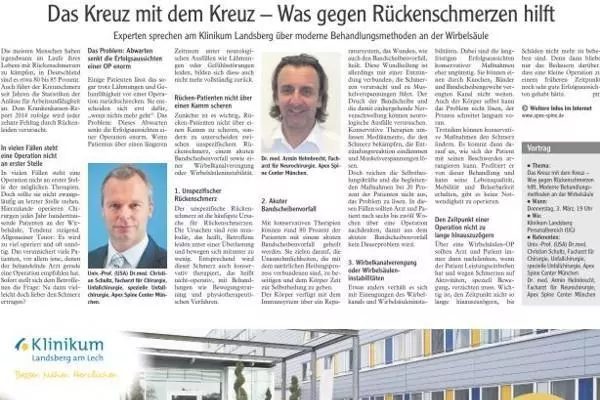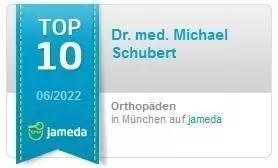What helps against back pain
Experts talk about modern treatment methods for the spine at the Landsberg Clinic
Most people have to struggle with back pain at some point in their lives, in Germany it is about 80 to 85 percent. Low back pain has also been at the top of the statistics for reasons for incapacity to work for years. According to the 2014 health insurance report, every tenth day of absence is caused by back problems.
In many cases, surgery is not the first priority
In many cases, an operation is not the first option among the possible therapies. But it shouldn't necessarily come last. In this country, surgeons operate on hundreds of thousands of patients on the spine every year, and the trend is rising. General tenor: too many surgeries are performed and they are often unnecessary. This unsettles many patients, especially those for whom the doctor treating them has just recommended an operation.
The question immediately arises for those affected: Well, then maybe it would be better to endure the pain?
The problem: Waiting reduces the chances of success of an operation enormously
Some patients even shy away from surgery despite being paralyzed and unable to walk. You only decide to do it "when nothing works anymore". The problem: Waiting and waiting enormously reduces the chances of success of an operation. If patients suffer from neurological deficits such as paralysis or sensory disturbances over a longer period of time, these also no longer completely regress.
Don't lump back patients together
First of all, it is important not to lump back patients together, but to differentiate between non-specific back pain, an acute herniated disc and a narrowing of the spinal canal
or spinal instability.
1. Non-specific back pain
Non-specific back pain is the most common cause of back pain. The causes are purely muscular, which means that those affected suffer from overload and sometimes move too little. Accordingly, this pain is also treated conservatively, i.e. non-operatively, with treatments such as movement training and physiotherapeutic procedures.
2. Acute disc herniation
With conservative therapies, around 80 percent of patients with an acute herniated disc can be cured. They aim to eliminate the discomfort associated with the natural healing process and allow the body time to heal itself. With the immune system, the body has a repair system that heals wounds, such as a herniated disc. This wound healing is
However, it is associated with inflammation that causes pain and leads to muscle tension. The pressure of the intervertebral disc and the associated nerve swelling can cause neurological deficits. Conservative therapies include drugs that control pain, reduce the inflammatory response, and relieve muscle tension. However, the self-healing powers and the accompanying measures are not sufficient in 20 percent of patients to solve the problem. In these cases, the doctor and patient should consider an operation after six to twelve weeks so that the acute herniated disc does not become a permanent problem.
3. Spinal canal narrowing or spinal instabilities
The situation is somewhat different with narrowing of the spinal canal and spinal instabilities. The long-term prospects of success of conservative measures are rather unfavourable. They cannot widen a canal narrowed by bone, ligaments, and disc tissue. Even the body itself cannot solve the problem, the process progresses slowly. Even so, conservative measures can ease the pain
alleviate. It then depends on how the patient can come to terms with his symptoms. If he benefits from this treatment and can maintain his quality of life, mobility and resilience, there is no need for surgery.
Do not delay the time of an operation for too long
The doctor and patient should always consider spinal surgery if the patient has a loss of performance and has to forego activities, especially movement, because of pain. It is important not to delay the point in time until damage can no longer be repaired. Because then there would only be regret that a small operation at an earlier point in time would have had very good prospects of success. pm
More information on the internet
www.apex-spine.de
lecture
● Theme:
The cross with the cross - what helps against back pain. Modern treatment methods on the spine
● When:
Thursday, March 3, 7 p.m
● Where:
Clinic Landsberg
Human Resources (UG)
● Speakers:
Univ.-Prof. (USA) Dr.med. Christian Schultz, specialist in surgery, trauma surgery, special trauma surgery, Apex Spine Center Munich
dr medical Armin Helmbrecht, specialist in neurosurgery, Apex Spine Center Munich
dr medical Armin Helmbrecht, specialist in neurosurgery, Apex Spine Center Munich.

